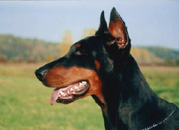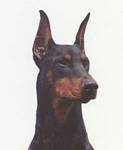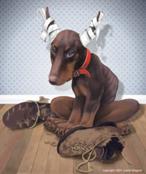The Doberman’s Ears
A Doberman’s ears are naturally floppy; without surgery a Doberman’s ears will not stand up.
 Our first recommendation is to make sure that ear cropping is *ONLY* be done by those who have a great deal of experience with this procedure. This surgery should performed by someone who specializes in the cropping of ears, because the expert cropping of ears is more an artistic endeavor than a technical surgical procedure such as spaying or neutering.
Our first recommendation is to make sure that ear cropping is *ONLY* be done by those who have a great deal of experience with this procedure. This surgery should performed by someone who specializes in the cropping of ears, because the expert cropping of ears is more an artistic endeavor than a technical surgical procedure such as spaying or neutering.
If you have NOT purchased your Doberman from a knowledgeable breeder, or are thinking of purchasing a Doberman, please inquire at your local kennel club for the name of an educated Doberman breeder/handler/vet in your area. This will allow you to see adult dogs (the length of their ears, the style of their crops, etc.), ask for advice about who did the cropping, and learn about the amount of time and commitment it takes to train the ears to stand properly.
There are three different lengths of ear crops:
|
 |
|
 |
|
 |
Ear cropping of the Doberman Pinscher is usually done at approximately 7 to 8 weeks of age. The operation requires anesthesia and the puppy must be kept from eating for approximately 12 hours prior to surgery. Although the procedure does require the puppy to be anesthetized, it may lessen your fears about cropping to know that the operation takes only 30 min. and the puppy is under anesthesia for only that time. The very first thing your puppy will want to do after being cropped is eat —- which shows you how much the whole procedure actually bothers a young puppy!!
For the first 7 days after ear cropping, your pup will remain in his rack (or cup), with sutures holding the edges closed. Between 7 and 10 days after cropping, the sutures will be removed, the cup changed. Again, for 7 to 10 days the pup will remain in his cup with the ears taped erect until all the cut edges are healed. Having the puppy’s ears up in a cup makes it very easy for you to keep the edges clean. Use peroxide to clean the edges of the ears and then dust the edges with BFI Powder to help dry them out. BFI Powder is also used for Athlete’s Foot and is readily available at most drugstores. If this is not available, just use the juice of an Aloe Leaf (or an ointment) to help heal the edges.
Although we often laugh at the prospect of seeing our Doberman Pups with cups on their heads, it really is the easiest way to keep the ears upright while they heal. Unfortunately, it is also usually very easy for the puppy to remove the cup with regularity. Because it is so important that the pup’s ears remain in the cup until they are completely healed, one must be extremely vigilant during this period. The way in which you care for a cropped ear has a huge impact on whether or not that ear will ever stand properly.
Ears should not be taped until most of the scabs from the surgery have healed. If there are only 1 or 2 scabs left, you can cover those with cotton and a little antibiotic powder and then tape over them.
There is no set amount of time it takes before a puppy’s ears will stand; the average time for taping is approximately 4-5 months. Most pups have their ears up by the age of 6 – 7 months. That said, it isn’t unusual for some ears not to stand until the pup is a year old. And some puppies have poor ear leather, which means that the ears won’t ever stand perfectly or the tips will curl inward. These problems can also be the result of a poor ear crop.
There are many methods of aftercare. Doberman ear crops should only be done under the guidance of an experienced Doberman vet/breeder/handler. Achieving ears that stand properly requires time and commitment on the part of the owner. Most agree that the ears should be taped for a week, then untapped long enough to allow the ears to breathe and dry out, then taped back up again. The longer the ears are left untapped, the longer it will take for them to stand on their own.

- Check for odors (The ears should not have a foul smell.)
- Keep the ears dry. If the ears get wet, rewrap them with dry tape.
- DO NOT take the ears down and let the ears “hang” for any length of time.
- If the ears fall — put them right back up in the roll.
